
|

|
|
Home Site Search Contact Us Subscribe
|
|
|
A Star is Reborn: Fox Oakland Theater and Oakland School for the Arts by Architectural Dimensions, ELS Architecture and Urban Design, and Starkweather Bondy Architecture Oakland, California: A faded movie palace - and the surrounding neighborhood - gets a new lease on life. By ArchNewsNow December 10, 2009 When the Fox Oakland opened in 1928 at the northern edge of downtown, it was one of the grand movie palaces of the day, its ornate architecture intended to evoke an exotic version of India and the Far East. Designed by San Francisco architectural firm Weeks & Day, the Fox had a vestibule with imported marble walls supporting a gold frieze beneath an ornately patterned dome; the 3,400-seat auditorium sparkled with gold leaf and gold light fixtures and had intricately painted walls, a stenciled plaster ceiling, and a stage flanked by two tall statues of Hindu warriors. Opening day drew a crowd of 20,000. Millions attended movies and performances at the Fox until the decline of downtown Oakland in the 1960s forced the theater to close. It remained largely unused for decades, suffering arson, vandalism, and neglect – and narrowly escaping being razed for a parking lot before being named to the National Register of Historic Places in 1979.
In February 2009, the theater reopened as a venue for live performances, the elaborate splendor of its historic elements restored by Berkeley-based ELS Architecture and Urban Design, which developed the original design concept for preservation and reuse of the theater. Architectural Dimensions of Walnut Creek, CA, was the lead architect for the renovation. The theater also houses the Oakland School of the Arts in two 3-story commercial wings that wrap around the building, designed by Oakland-based Starkweather Bondy Architecture.
The process was lengthy and complex, but through a public-private partnership, the Fox – and the surrounding neighborhood – has a new lease on life.
The city’s redevelopment agency acquired the theater in 1996 with the hope of restoring it as the centerpiece of a new arts and entertainment district intended to revitalize the neighborhood known as Uptown. Three years later, the city repaired the roofs to preserve the interiors from further rain damage, and a year later restored the 1929 blade sign and 1935 marquee. But the prospect of undertaking the repairs and renovations necessary to seismically strengthen the building and restore it to its former glory was daunting because of the expense. The city commissioned a master plan to devise ways to reuse the theater and sought a developer to partner with. The site had the benefit of being steps away from the 19th Street BART station, and a 50,000-square-foot commercial building wrapped around the theater. Various developers had expressed interest over the years (the Rouse Company offered a scheme for including the Fox in a downtown retail/mixed use development in the 1980s), but none of the proposals came to fruition.
Then Phil Tagami, managing partner of the local development firm California Commercial Investments, stepped forward in 2003. Tagami had a track record for handling similar projects locally, having restored a Beaux Arts-style Rotunda department store building across from Oakland’s City Hall into an office and retail building. Due to limited funds, the initial proposal – referred to as the “ruins” scheme – was to restore only the orchestra level of the theater as a 500-seat cabaret, which could be accomplished relatively quickly to help stimulate regeneration as soon as possible. But the plan did not include a restoration of the building’s elaborate decorative finishes.
The project finally gained momentum in 2005 with Mayor Jerry Brown’s support for converting the space in the attached commercial structure for the Oakland School for the Arts, a public charter middle and high school that was outgrowing its existing home. Interest in reviving the Fox proved so strong, however, that the plan expanded. Tagami and the city worked to find additional funding, which ultimately included a $25.5 million loan from the redevelopment agency, state historic preservation and federal new market tax credits, private donations, and grants. In addition, a deal was struck between the Port of Oakland and outdoor advertising company CBS Outdoor, providing $6.5 million as an upfront payment for the first seven years of rent for the school; in return, CBS Outdoor was allowed to construct an electronic billboard at the foot of the Bay Bridge.
The $58 million project involved seismic retrofitting, cleaning and rehabilitating the exterior, cleaning and restoring decorative painting on the interior, and restoring the theater’s cast plaster ceiling. New sound and lighting systems were added, as well as a new HVAC and mechanical, electrical, and plumbing systems. The restoration acknowledges two historic periods of significance: 1928, when the interior and exterior were built, and 1946, when the entry and lobby were remodeled in the Art Deco style. The Fox’s historic commercial space was renovated and complemented with select new construction to accommodate approximately 40,000 square feet of educational program space for the Oakland School for the Arts, including classrooms, administrative offices, and student services, as well as music, dance, drama, and art studios.
Managed for the city by the Berkeley-based concert production firm Another Planet, the Fox serves as a counterpart to the Paramount Theatre a few blocks up Telegraph Avenue. The Paramount, a city-owned 3,000-seat Art Deco venue that opened in 1931 as a vaudeville house, was renovated and restored in 1973 as a performing arts venue, hosting the Oakland Symphony and Oakland Ballet, as well as concerts and movies. The Fox focuses more on popular entertainment acts, such as blues musicians and independent music bands, and it offers flexible seating for 1,500 to 2,800, depending on whether the auditorium is configured as terraced seating, cabaret-style seating with tables, or a dance floor. The balcony alone has seating for 1,000.
In recent years, the Uptown district surrounding the Fox has been experiencing a surge of development, including art galleries and residential buildings. The three-building Uptown complex by developer Forest City opened in 2008, with 665 residences in three buildings as well as a new public park and commercial space. New restaurants and bars are also continuing to open in the neighborhood, despite the economic downturn.
The Oakland School for the Arts opened in its location at the Fox in January of 2009, and the Fox Theater opened in February. The place is now abuzz with as many as 500 art students using the facility during the day, and patrons watching shows, dining in its on-site restaurant and bar, and visiting other local businesses in the evening and on weekends.
Client: California Commercial Investments, Oakland, CA Lead Architect for Restoration: Architectural Dimensions, Walnut Creek, CA Historic Architect for Restoration: ELS Architecture and Urban Design, Berkeley, CA Architect for Oakland School for the Arts: Starkweather Bondy Architecture, Oakland, CA Structural Engineer: The KPA Group, Oakland, CA Environmental & Geotechnical Consultant: Treadwell & Rollo, Oakland, CA Contractor: Turner Construction, Oakland, CA Photography: David Wakely Photography and Ken Gutmaker Photography
ELS Architecture and Urban Design has a 40-year history of designing public places including performing arts, theaters, and historic renovations; mixed-use and urban design; and community, recreation and education projects. In addition to the Fox Oakland Theater, the firm’s portfolio includes the California Theatre in San Jose; the Arlene Schnitzer Concert Hall at the Portland Center for the Performing Arts; the Grand Theatre Center for the Arts in Tracy, CA; Sundance Kabuki Cinemas in San Francisco; the Roda Theatre at Berkeley Repertory Theater; and NOKIA Theatre L.A. LIVE in Los Angeles. The firm’s designs have been honored with more than 120 international, national, regional, and local awards for design excellence.
Architectural Dimensions, based in Walnut Creek, is a planning and architecture firm founded in 1982. The firm’s experience includes master planning; tenant improvements; mixed-use developments that involve retail, office, and hotels; and the development of prototypes for large national restaurant and hotel chains. Projects include the restoration of the historic Rotunda building in Oakland, the design of the Marriott Hotel in Fremont, and the design of the Music Building at the University of Louisville.
Starkweather Bondy Architecture is an Oakland-based architectural, interiors, and planning firm established in 2001 by Phred Starkweather and Bill Bondy. The firm is a leader in independent school design and planning, completing a broad range of projects for early childhood education and K-12 institutions. Its diverse portfolio includes theaters, recreational facilities, libraries, classroom buildings, commercial offices, and custom residences. In addition to the Oakland School for the Arts, recent projects include a sustainable urban master plan for the San Francisco School, Marin Academy Library Center, and Silicon Valley Preschool.
|
(click on pictures to enlarge) 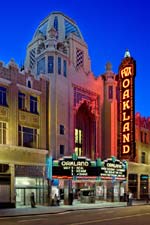 David Wakely Photography The Fox Oakland opened in 1928 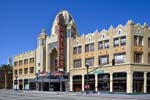 David Wakely Photography The building and marquee viewed from Telegraph Avenue 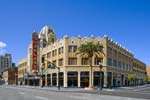 David Wakely Photography Former office space facing the street now houses the Oakland School of the Arts 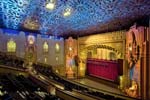 David Wakely Photography In February 2009, the theater reopened as a venue for live performances, the elaborate splendor of its historic elements restored; here the auditorium is configured as terraced seating 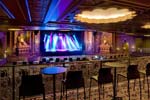 David Wakely Photography The theater configured with cabaret-style seating and tables 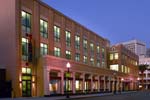 Ken Gutmaker Photography The Oakland School for the Arts’ classrooms are integrated into the upper floors of the historic Fox Theater building, while a new addition houses larger rehearsal studios, a black box theater and student center 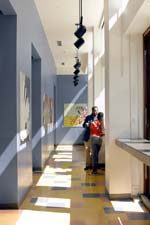 Ken Gutmaker Photography Music and dance studios are set back from the façade of the new addition, creating a light-filled space for socializing and displaying student art 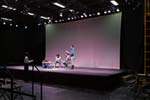 Ken Gutmaker Photography Students rehearse in the black box theater 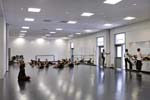 Ken Gutmaker Photography Dance students warming up before a class |
© 2009 ArchNewsNow.com